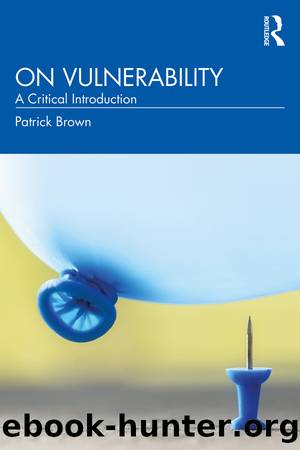On Vulnerability by Patrick Brown

Author:Patrick Brown [Brown, Patrick]
Language: eng
Format: epub
Tags: Social Science, Sociology, General
ISBN: 9781000400298
Google: -fMxEAAAQBAJ
Publisher: Routledge
Published: 2021-07-12T05:07:27+00:00
What we see most explicitly here is a brief narrative of hope. But we also see the probability of the future expressed as a risk calculation â 0.5 per cent. Now, we do not know what exactly Thijsâs doctor had in mind when naming this fraction of a percentage. This may have been a way of expressing that this possibility was distinctly unlikely, but not entirely inconceivable. It may though have been based on a review of patient outcomes that the doctor had read. In any case, Thijs appeared to trust in his doctor that this probabilistic estimate was a genuine one and focused on the 0.5 per cent in a way that imbued this possibility with hope. What we see therefore in these three lines of text is a bricolaging of rational-calculative risk, non-rational hope and the âin-betweenâ strategy of trust (Zinn 2008).
But it is not just patients who combine these different forms; doctors do it too. While Levi-Strauss contrasted this bricoleur with the scientific expertise of the engineer, Horlick-Jones and colleagues (2007) follow Lynch (1993) in recognising that this expert-lay distinction is a false one and that we are all bricoleurs, professional-experts and âlayâ people alike. Zinn (2008) points to the necessity and efficacy of combinations of approaches, in that âthey facilitate more effective control over the futureâ (p. 339), for everyday citizens as well as professionals, who both need to make quick decisions with limited resources (p. 444). Zinn goes further to review a range of studies that suggests that, at least in some settings, the use of heuristics leads to better outcomes than calculative-modelling approaches (ibid.; see also Crandall and Getchell-Reiter 1993).
In order to make this latter point that experts are bricoleurs too and to break down the expert-lay dualism that has structured a great deal of social science thinking on risk, Zinn adopted a language of (non)-rationality in articulating his spectrum of strategies. In the next section I will sketch a different way of conceptualising Zinnâs spectrum of strategies through a reading of his 2008 work that focuses more on knowledge. This will then lay the basis for the further development of three core concepts, which lie at the heart of this chapter â hope, trust and magic â drawing particularly on my own research (with various colleagues) in hospital and treatment contexts in the UK and the Netherlands.
Magic becomes hidden by binary thinking But before we head further into the chapter, may be you are sceptical as to whether I have really found practices of magic (!) in late-modern northern Europe. I would suggest to you that this scepticism (though understandable) is perhaps rooted in a binary in many of our academic lifeworlds, one that is just as potent, problematic and yet deeply rooted as the expert-lay binary which Lynch, Horlick-Jones and colleagues and Zinn have sought to destabilise. This other key binary, which shapes a lot of our thinking on how we handle risk and uncertainty in contemporary societies, is the simplistic association
Download
This site does not store any files on its server. We only index and link to content provided by other sites. Please contact the content providers to delete copyright contents if any and email us, we'll remove relevant links or contents immediately.
The Four Agreements by Don Miguel Ruiz(5512)
Flow by Mihaly Csikszentmihalyi(4055)
You Do You by Sarah Knight(4027)
The Four Tendencies by Gretchen Rubin(4025)
Adulting by Kelly Williams Brown(3674)
The Hacking of the American Mind by Robert H. Lustig(3581)
A Simplified Life by Emily Ley(3573)
Right Here, Right Now by Georgia Beers(3499)
The Power of Positive Thinking by Norman Vincent Peale(3453)
The Art of Happiness by The Dalai Lama(3386)
Ikigai by Héctor García & Francesc Miralles(3147)
The Little Book of Hygge by Meik Wiking(3081)
The French Women Don't Get Fat Cookbook by Mireille Guiliano(2984)
The Heroin Diaries by Nikki Sixx(2933)
The Choice by Edith Eva Eger(2897)
Why Buddhism is True by Robert Wright(2828)
The Courage to Be Disliked by Ichiro Kishimi & Fumitake Koga(2799)
Spark Joy by Marie Kondo(2680)
Make Your Bed by William H. Mcraven(2680)
